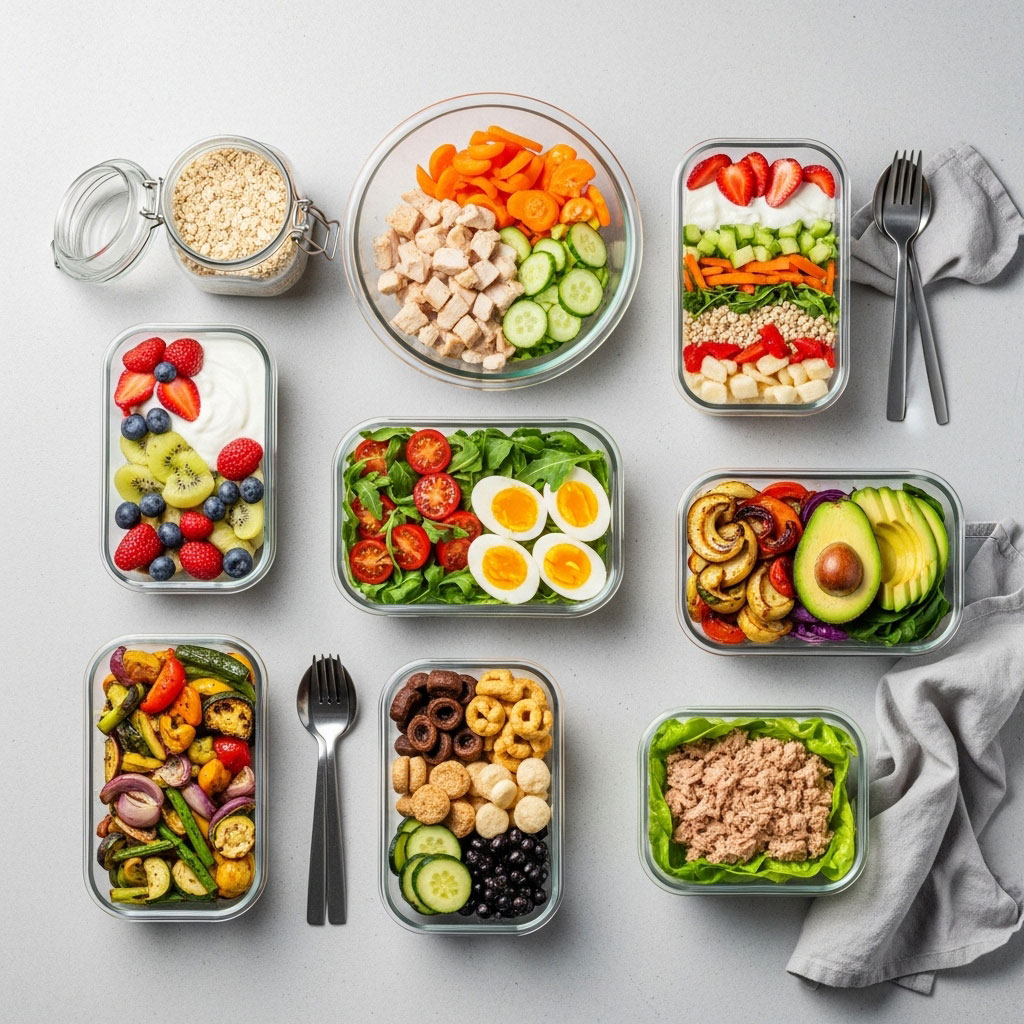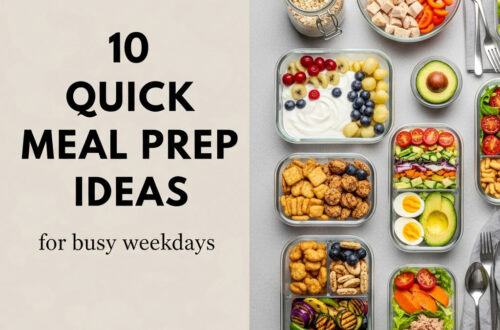-
5-Minute High-Protein Breakfasts for People Who Hate Mornings

If you hit snooze three times and rush out the door with coffee in hand, you’re not alone. But skipping breakfast—or grabbing a sugary one—can lead to crashes, cravings, and poor focus all day. What if you could eat a filling, high-protein breakfast in under 5 minutes? This post gives you 7 no-fuss, energizing breakfasts you can prep fast—no early wake-ups required.
Why Protein at Breakfast Matters
- Keeps you full longer
- Reduces mid-morning cravings
- Supports lean muscle and metabolism
- Stabilizes blood sugar
The goal: 15–25g of protein at breakfast.
7 Quick High-Protein Breakfast Ideas
- Greek Yogurt Parfait (25g protein)
Layer 1 cup plain Greek yogurt with berries, chia seeds, and a sprinkle of granola. Add a scoop of protein powder if desired. - Cottage Cheese Bowl (20g protein)
Top 1 cup cottage cheese with sliced banana and a drizzle of peanut butter or cinnamon. - Protein Smoothie (25g+ protein)
Blend 1 scoop protein powder, ½ banana, 1 tbsp peanut butter, almond milk, and spinach. Store ingredients in freezer packs for speed. - Egg Muffin Cups (20g protein)
Make these ahead: Whisk 6 eggs with chopped veggies and cheese. Pour into muffin tins and bake 20 min at 350°F. Store and reheat. - Peanut Butter Protein Toast (18g protein)
Toast whole grain bread, top with 2 tbsp peanut butter and hemp seeds or protein powder mixed in. - Boiled Eggs + Fruit (15g protein)
Boil a batch of eggs and pair 2 with a banana and a handful of nuts. Perfect for grab-and-go. - Oatmeal Protein Boost (20g protein)
Stir ½ scoop vanilla protein powder into cooked oats. Add berries, flaxseeds, or almond butter.
What About Breakfast Meal Prep?
Prep 2–3 of these on Sunday:
- Egg muffins
- Boiled eggs
- Portion yogurt into jars
- Make smoothie freezer bags
Don’t skip breakfast just because mornings are hectic. With a few easy go-tos, you can fuel your body in minutes—and set your day up for success. Want a full 7-day breakfast guide? Download the Healthy in a Hurry Meal Plan below totally free.
-
The Busy Professional’s Guide to Eating Clean Without Cooking Every Day

You want to eat clean. You don’t want to spend hours in the kitchen every day. Between meetings, commutes, workouts, and maybe even parenting, your time is limited—and that’s okay. Clean eating isn’t about daily gourmet meals. It’s about making simple, smart choices you can repeat consistently. In this guide, you’ll learn exactly how to eat clean throughout the week with minimal daily cooking—and zero food guilt.What Does “Clean Eating” Actually Mean?
Clean eating is about:
- Whole, minimally processed foods
- Balance of protein, fiber, and healthy fats
- Hydration and nutrient density
- Avoiding artificial additives or excess sugar
No, it doesn’t mean only eating salads or quitting carbs.
The 80/20 Rule for Clean Eating
Perfection isn’t required. Focus on eating clean 80% of the time, and allow 20% flexibility. It’s sustainable, balanced, and realistic. Examples:
- Monday–Friday: planned meals
- Saturday dinner: pizza or dessert
That’s clean eating without the burnout.
How to Set Up a No-Cook (or Low-Cook) Clean Eating Routine
Step 1: Stock Your Kitchen with “Clean” Shortcuts
Keep your fridge and pantry stocked with:
- Proteins: Rotisserie chicken, tuna packs, hard-boiled eggs, Greek yogurt
- Veggies: Pre-washed greens, frozen mixed vegetables, baby carrots
- Carbs: Microwavable brown rice, quinoa packs, sweet potatoes
- Fats: Avocados, olive oil, nut butters
Step 2: Choose 3-Minute Meals for Each Time Block
Examples:
- Breakfast: Greek yogurt + fruit + granola
- Lunch: Whole grain wrap + chicken + hummus + spinach
- Dinner: Steamed frozen veggies + canned lentils + microwave quinoa
- Snacks: Apple + almond butter, cottage cheese, boiled eggs
Step 3: Use the “Pair and Build” Method
Pair 1 protein + 1 veggie + 1 carb.
Example: Tuna + spinach + rice
Add olive oil or avocado for flavor and fat. Done in under 5 minutes.Step 4: Don’t Fear Repetition
It’s okay to eat the same meal multiple times during the week. Clean eating thrives on simplicity and consistency.
Step 5: Plan 1–2 “Assembly Days” Per Week
You don’t have to cook—just assemble:
- Pre-cut veggies
- Portion yogurt or oats into jars
- Make snack packs
- Store in glass containers for grab-and-go options
Smart Clean Eating Swaps
- White rice → quinoa or farro
- Flavored yogurt → plain Greek yogurt + honey
- Creamy dressings → olive oil + vinegar
- Chips → roasted chickpeas or nuts
- Granola bars → boiled eggs + fruit
When You Do Cook, Make It Count
Batch-cook a simple stir-fry or soup that can be portioned for multiple meals. Bonus: these freeze well too.
Clean eating doesn’t require cooking every day. With a few clean staples, quick prep, and flexible meals, you can nourish your body without the kitchen taking over your life. Need help putting it together? Download your free “Healthy in a Hurry” 7-Day Meal Plan below designed just for busy people like you.
-
How to Build a 30-Minute Meal Plan That Actually Works

If you’ve tried following strict meal plans before, you know how frustrating they can be. They often assume hours of free time or exotic ingredients. But what busy professionals need is flexibility—without compromising on health. In this post, you’ll learn a repeatable system for creating a healthy weekly meal plan that fits into 30-minute blocks of prep time. Bonus: it works whether you cook daily or batch your meals all at once.Why Traditional Meal Plans Fail:
- They’re too rigid
- Don’t fit changing schedules
- Require hard-to-find ingredients
- Take too long to prep
A better plan starts with you: your routine, your preferences, and your time limits.
Step 1 – Choose Your Weekly Staples
Pick 1–2 breakfast, lunch, and dinner options you can rotate. Repetition is your friend. Example:
- Breakfasts: Overnight oats, Greek yogurt + berries
- Lunches: Chicken wraps, quinoa bowls
- Dinners: Stir-fry, sheet pan meals
Step 2 – Stick to Core Ingredients
Rotate 2 proteins, 3 veggies, 2 carbs each week. Example:
- Proteins: Eggs, grilled chicken
- Veggies: Spinach, broccoli, bell peppers
- Carbs: Quinoa, oats
Step 3 – Batch in Time Blocks
Instead of full meals, batch-cook components. While quinoa cooks, you can pan-sear chicken and chop veggies. You’ll have mix-and-match ingredients in 30 minutes or less.
Step 4 – Mix and Match Meals
Now combine what you’ve prepped:
- Breakfast: Oats with fruit
- Lunch: Chicken + quinoa + greens bowl
- Dinner: Stir-fry with rice and veggies
Step 5 – Use Smart Backups
Always have frozen meals, healthy snacks, or ready-to-go smoothies on hand. Life happens—be ready.
Meal planning doesn’t need to be rigid or complicated. A few core ingredients, a flexible prep session, and repeatable meals go a long way. Want a plug-and-play system to get started? Download your free 7-Day Meal Plan for Busy People below with a grocery list and daily guide.
-
10 Quick Meal Prep Ideas for Busy Weekdays

Meal prepping is the unsung hero of staying healthy on a tight schedule. Whether you’re juggling Zoom meetings or commuting across town, prepping meals ahead saves time, money, and decision fatigue. But who has time to spend hours in the kitchen every Sunday? Not you. That’s why these 10 quick meal prep ideas are designed to take 30 minutes or less while using simple, real-food ingredients. You’ll find high-protein, balanced options that store well and keep you full—all without a culinary degree.Why Meal Prep Matters for Busy People:
Meal prepping isn’t just about saving time—it’s about setting your future self up for success. A fridge stocked with ready-to-eat meals helps:- Reduce the temptation of takeout
- Improve portion control
- Stay aligned with fitness and health goals
- Save money from last-minute food runs

Let’s break down 10 go-to meal prep ideas you can rotate every week.
1. Overnight Oats Jar
Combine ½ cup rolled oats, 1 tbsp chia seeds, 1 cup almond milk, and ½ cup berries in a mason jar. Refrigerate overnight. In the morning, stir and top with nut butter or protein powder. This is a no-cook, fiber-rich, and customisable breakfast that holds up for 3–4 days.2. Rotisserie Chicken Bowls
Pick up a pre-cooked rotisserie chicken. Shred the meat and portion into containers with microwavable brown rice and steamed frozen broccoli. Change it up with sauces—BBQ one day, teriyaki the next.3. Greek Yogurt Snack Packs
Portion plain Greek yogurt into jars or containers and top with a small handful of nuts, granola, or berries. Great for post-lunch sweet cravings or mid-morning fuel.4. Mason Jar Salads
Layer in this order to avoid sogginess: dressing, firm veggies (carrots, bell peppers), grains or protein, then greens. Seal and refrigerate. Shake to mix when ready to eat.5. Hard-Boiled Eggs + Avocado Toast Kit
Boil a dozen eggs at once. Store with whole grain bread and a container of mashed avocado or guacamole. Just toast, top, and eat. Add chili flakes for a metabolism kick.6. One-Pan Roasted Veggie Packs
Dice sweet potatoes, bell peppers, and zucchini. Toss in olive oil and spices, roast at 400°F for 25 minutes. Portion with chickpeas, quinoa, or grilled chicken.7. Protein Snack Boxes
Build a “bento box” with turkey slices, cheese cubes, cucumber rounds, nuts, and grapes. These are perfect for grazing during the workday without hitting the vending machine.8. Tuna Wraps or Lettuce Cups
Mix canned tuna with Greek yogurt, mustard, and chopped celery. Scoop into whole grain wraps or romaine leaves. Crunchy, satisfying, and protein-rich.9. Smoothie Freezer Packs
Pre-bag spinach, berries, banana slices, and protein powder. Store in the freezer. Just add milk or water and blend. Instant breakfast in 2 minutes.10. Chickpea Power Bowls
Toss canned chickpeas with olive oil, lemon juice, and herbs. Add cooked quinoa, spinach, and shredded carrots. Top with a sprinkle of feta cheese for flavor.How to Make It Stick:
Start with just 2–3 of these ideas each week. Don’t overwhelm yourself trying to prep every meal. The key is progress, not perfection.Meal prep is your shortcut to a healthy lifestyle—even with a packed calendar. These quick ideas help you eat better, reduce stress, and save time every week. Want a complete plan with a full grocery list and 7 days of done-for-you meals? Grab your free copy of “Healthy in a Hurry: 7-Day Meal Plan for Busy People” below.
-
6 Easy Ways to Clear Your Mind
In our fast-paced world, it’s easy to feel overwhelmed by the constant flow of information and daily responsibilities. A cluttered mind can lead to stress, anxiety, and decreased productivity. However, there are simple techniques you can adopt to help clear your mind and regain focus. Here are six effective ways to achieve mental clarity:
1. Practice Mindfulness Meditation
What it is: Mindfulness meditation involves paying attention to the present moment without judgment. It encourages awareness of thoughts, feelings, and bodily sensations.
How to do it: Start by finding a quiet space where you can sit comfortably. Close your eyes and take a few deep breaths. Focus on your breathing—notice the sensation of air entering and leaving your body. If your mind starts to wander, gently bring your focus back to your breath. Even just five minutes a day can make a significant difference.
Benefits: Regular practice can reduce stress, enhance concentration, and promote emotional well-being. By learning to observe your thoughts without getting caught up in them, you create mental space and clarity.
2. Go for a Walk in Nature
Why it helps: Nature has a calming effect on the mind. Being outdoors allows you to disconnect from your daily routine and immerse yourself in a different environment.
How to do it: Find a local park, nature trail, or even a quiet street to stroll. As you walk, pay attention to your surroundings—notice the colors of the leaves, the sounds of birds, or the feeling of the breeze. If possible, leave your phone behind or silence it to minimize distractions.
Benefits: Walking in nature has been shown to lower stress levels, improve mood, and enhance creativity. The physical activity combined with fresh air and natural scenery can rejuvenate your mind and help you think more clearly.
3. Write It Down
The power of journaling: Writing can be a powerful tool for clearing your mind. When you put your thoughts on paper, you externalize your worries and organize your ideas.
How to do it: Set aside a few minutes each day for journaling. You can write about anything—your feelings, daily experiences, or even a to-do list. Don’t worry about grammar or structure; the goal is to express yourself freely.
Benefits: Journaling can help you identify patterns in your thoughts and feelings, making it easier to address issues that weigh on your mind. It’s also a great way to track progress toward personal goals and celebrate small victories.
4. Limit Distractions
Why it matters: In an era of constant notifications and information overload, it’s crucial to create boundaries that allow for mental clarity.
How to do it: Identify the distractions that most affect you—this could be social media, emails, or even background noise. Consider setting specific times to check your phone or email, rather than allowing them to interrupt your day. You can also create a distraction-free workspace by organizing your environment and reducing clutter.
Benefits: By limiting distractions, you create a more conducive atmosphere for focus and productivity. This intentional approach can lead to deeper work sessions, greater creativity, and improved problem-solving abilities.
5. Engage in Physical Activity
The connection between body and mind: Exercise is not just beneficial for physical health; it also plays a vital role in mental clarity. Physical activity releases endorphins, which can improve your mood and reduce stress.
How to do it: You don’t need a gym membership to reap the benefits of exercise. Find an activity you enjoy, whether it’s dancing, cycling, swimming, or practicing yoga. Aim for at least 30 minutes of moderate activity most days of the week.
Benefits: Regular exercise can enhance cognitive function, improve sleep, and increase overall energy levels. The rhythmic movements and focus required in physical activity can serve as a form of meditation, helping to clear your mind of racing thoughts.
6. Practice Deep Breathing
Why it works: Deep breathing is a simple yet powerful technique to calm the mind and body. It activates the body’s relaxation response, countering the effects of stress.
How to do it: Find a comfortable position, either seated or lying down. Inhale deeply through your nose for a count of four, hold your breath for a count of four, and then exhale slowly through your mouth for a count of six. Repeat this cycle for several minutes, focusing solely on your breath.
Benefits: Deep breathing can help reduce anxiety and promote a sense of calm. It’s an excellent practice to incorporate throughout your day, especially during stressful moments, as it can quickly bring you back to a place of clarity and focus.
-
How to Overcome Laziness and Find Motivation
Discover the root causes of laziness and unlock the keys to renewed motivation!
Feeling sluggish and uninspired lately? You’re not alone. Many of us find ourselves in a slump, struggling to find the drive to tackle our daily tasks.
But here’s the good news: you have the power to break free from the grip of laziness and reclaim your motivation.
Let’s face it: persistent laziness can stand in the way of your success, whether it’s in your career, education, or personal life. But with the right strategies, you can overcome inertia and propel yourself towards your goals.
So, let’s take action! Explore six invaluable tips to reignite your drive and transform your life for the better.
Exploring the Roots of Laziness: 7 Potential Causes
To effectively address laziness, the initial step is identifying its underlying causes. Various factors can contribute to feelings of laziness, each requiring thoughtful consideration. Recognizing these causes empowers you to develop strategies for enhancing motivation and productivity. Here are some common culprits:
Procrastination
Procrastination entails delaying crucial tasks or projects. When we defer necessary work, laziness often ensues. Whether the task is urgent or not, completing it promptly is advantageous. Understanding this dynamic helps to combat procrastination and alleviate feelings of laziness, preventing long-term complications.
Lack of Clear Goals
Clarity regarding life goals is essential for maintaining motivation and drive. Uncertainty about one’s aspirations can impede action. Take time to define your objectives and the steps required to achieve them. Clear goals provide direction, fueling motivation and propelling progress.
Lack of Self-Discipline
Self-discipline, the ability to regulate behavior and actions, is fundamental to success. Without it, succumbing to procrastination becomes more likely. Fortunately, self-discipline is a skill that can be cultivated through practice and determination over time.
Your Comfort Zone
Preferring familiar activities over new challenges can foster a sense of laziness. Resisting opportunities for growth limits personal development and fulfillment. Stepping outside your comfort zone regularly exposes you to new experiences, invigorating motivation and combating apathy.
Perfectionism and Fear of Failure
Perfectionism entails setting excessively high standards and being overly critical of potential flaws or mistakes. Perfectionists often establish unrealistic goals, fostering a fear of failure and aversion to risk-taking. Consequently, tasks may be avoided or left incomplete due to the fear of not achieving perfection. It’s essential for perfectionists to recognize the importance of striving for continuous progress rather than fixating on unattainable perfection.
Unhealthy Lifestyle
An unhealthy lifestyle characterized by poor habits can lead to decreased energy levels and increased fatigue. This diminished vitality may result in a lack of motivation to engage in physical and mental activities. Furthermore, an unhealthy lifestyle can exacerbate overall physical and mental well-being, negatively impacting mood and focus, ultimately contributing to a lack of self-discipline.
Experiencing Burnout or Stress
Feeling overwhelmed and burnt out rather than lazy may indicate excessive work without adequate self-care. Constant fatigue and decreased productivity signal the need for rest and recovery. Recognizing the signs of burnout is crucial for implementing necessary measures to address it and restore well-being.
How to Overcome Laziness and Lack of Motivation
Having identified the underlying reasons for laziness and lack of motivation, it’s time to take action, no matter how small, to regain momentum. Despite initial confusion, it’s important not to lose hope. Here are some strategies to combat laziness and cultivate motivation, allowing you to live life to its fullest.
- Clarify Your Goals
To shake off laziness and regain motivation, clarity on your goals is paramount. Dedicate some time to introspection and establish precise objectives rather than vague aspirations. Whether it’s in your professional endeavors, academic pursuits, relationships, or personal growth, define what you aim to accomplish.
For instance, instead of a generic goal like “improve my performance at school/university,” specify a target such as “enhance my math grades within the next couple of months.” This clarity provides a clear direction, making it easier to stay driven and devise effective strategies to attain your goals.
- Master Prioritization
Learning to prioritize is another crucial tactic. Feeling overwhelmed often leads to inertia and lack of motivation. Instead of grappling with an extensive to-do list, concentrate on one to five tasks each day that hold the utmost significance. This approach not only prevents procrastination but also fosters productivity.
Consider journaling and breaking down large tasks into smaller, manageable segments. By dividing tasks into achievable chunks, you’ll have a clear starting point and can monitor progress more effectively. Acknowledging your advancements naturally bolsters motivation and productivity.
- Infuse Excitement into Life
Combating laziness entails stepping out of your comfort zone and infusing life with excitement. Embrace new experiences and challenges to invigorate your routine. Explore unfamiliar locales, acquire new skills, and engage with different people regularly.
Delve into activities you’ve postponed on your to-do list, igniting newfound enthusiasm for life’s possibilities.
- Embrace Imperfection and Learn from Mistakes
Overcoming the fear of failure is essential for banishing laziness. Accept imperfections and mistakes as part of the learning process. Opt for progress over perfection, even if it means completing tasks with less-than-ideal outcomes.
Striving for unattainable perfection often leads to stress and self-doubt. Set deadlines and focus on continuous improvement within those timeframes, fostering a healthier approach to achievement.
- Maintain a Healthy Routine
A healthy daily routine is instrumental in combating laziness and maintaining motivation. Prioritize adequate sleep, nutritious meals, and regular exercise to bolster energy levels and focus.
A structured routine instills a sense of purpose and helps ward off feelings of aimlessness. Cultivate self-discipline and good habits to tackle procrastination head-on.
- Embrace Downtime
Recognize that occasional laziness is natural and incorporate downtime into your routine without guilt. Balancing productivity with rest is vital for sustainable motivation and well-being.
By embracing periods of relaxation, you’ll develop a healthier perspective on work and leisure, preventing burnout and fostering a positive mindset.
In Conclusion
Identifying the root causes of laziness is the first step towards overcoming it. Implementing tailored strategies to address these obstacles cultivates motivation, productivity, and satisfaction across various facets of life.
Remember to be patient with yourself and persevere through setbacks. Sustainable improvements require time, effort, and a positive mindset.
-
20 Ways to Eat Healthier Without Dieting
In a world where people often follow trendy diets and have big expectations, trying to eat healthier can feel like a big challenge. But guess what? You don’t have to do anything extreme to eat better!
By making small, doable changes to your daily routine, you can feed your body well without having to stick to a strict diet plan. Here are 20 simple ways to eat healthier and feel good in the long run:
Enjoy Your Meals: Take your time eating, enjoy each bite, and pay attention to the flavors. This helps you recognize when you’re full.
Drink Water: Keep yourself hydrated by sipping water throughout the day. Add some slices of citrus or cucumber for a tasty twist.
Eat Colorful Veggies: Make your meals more exciting by adding lots of colorful vegetables. Each color brings different nutrients!
Choose Whole Grains: Go for whole grains like brown rice and oats instead of refined ones. They’re packed with fiber and other good stuff.
Snack Wisely: Pick healthier snacks like fresh fruit, nuts, or Greek yogurt instead of processed ones. They keep your energy levels steady.
Control Portions: Use smaller plates and listen to your body to avoid overeating.
Cook at Home: Try cooking at home to have control over what you eat. It’s fun and healthy!
Include Protein: Make sure to have protein in your meals for muscle repair and feeling full.
Cut Down on Sugar: Watch out for hidden sugars in processed foods and go easy on sugary drinks.
Listen to Your Body: Pay attention to when you’re hungry and when you’re full. Your body knows best.
Enjoy Treats in Moderation: It’s okay to have your favorite treats sometimes. Just don’t overdo it!
Eat Healthy Fats: Get your fats from sources like avocados and nuts. They’re good for you!
Have Balanced Meals: Aim for a mix of carbs, proteins, and fats in each meal for lasting energy.
Stay Active: Move your body regularly to stay healthy. Find something you enjoy doing!
Limit Processed Foods: Try to eat less processed foods and go for whole, natural options instead.
Pack a Healthy Lunch: Make your own lunch to avoid unhealthy takeout. It’s a great way to get the nutrients your body needs.
Eat a Variety: Include lots of different foods in your diet to get a wide range of nutrients.
Plan Ahead: Plan your meals and snacks in advance to avoid unhealthy choices when you’re hungry.
Celebrate Progress: Be proud of the small steps you take towards healthier eating. Every little bit counts!
Get Enough Sleep: Make sure to get a good night’s sleep. It helps you make better food choices.
In conclusion, eating healthier doesn’t have to be hard or strict. Just follow these simple tips and focus on making choices that make you feel good inside and out!








